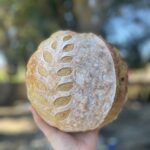
Sourdough Recipe for beginners step-by-step
Servings: 1 boule
My beginner sourdough bread recipe has been viewed over 1 million times across my social media platforms and has helped thousands of people bake their first successful loaf. With a simple, approachable method, it proves that sourdough doesn’t have to be complicated!
Print Recipe
Equipment
- 1 Medium/Large bowl
- 1 Dutch Oven or Bread Oven See blog post if you don't have one
Ingredients
Sourdough Starter
- 50g or 1/4 cup Sourdough starter
- 50g or 1/4 cup Unbleached Bread Flour
- 50g or 1/4 cup Filtered room temperature water
Sourdough Recipe
- 100g or 1/2 cup Active Sourdough Starter
- 350g or 1 & 2/3 cup Filtered warm water about 80 degrees F
- 500g or 4 cups Unbleached Bread Flour King Arthur bread flour is my favorite
- 10g or 2 tsp Sea Salt
Instructions
How to feed your sourdough starter
- Start with 50g of your sourdough starter in a new clean jar. Pour 50g of unbleached bread flour into the jar. Add 50g of filtered room temp or luke warm water. Stir everything together until the mixture is smooth and no dry flour remains. Loosely cover the jar with a lid and let it sit at room temperature for about 4-6 hours, depending on warmth and activity. Your starter is ready to use when it has doubled in size and is bubbly!
How to make your sourdough loaf
- To a big bowl, add 100g of active starter and 350g of warm filtered water. Mix to combine until water looks milky and starter is dissolved. Then, add in your 500g of bread flour and 10g of salt. Mix to combine into a shaggy dough. If needed, you can add small amounts of water if your dough is too dry, water absorption varies in different flours and climates. Cover with a damp towel or plastic bowl cover, let rest for 1 hour at room temperature.
- After letting the dough rest for 1 hour, its time to do a series of stretch and folds. With wet hands take a corner of your dough and stretch up and fold it over itself making sure to repeat with all 4 sides. You will do 4 rounds of stretch and folds with 30 minute rests in between. Cover with a damp towel or plastic cover in between rounds to keep in moisture. Example: Stretch and fold #1, 30 min rest, stretch and fold #2, 30 min rest, stretch and fold#3, 30 min rest, Stretch and fold #4, finishing with a rest called bulk fermentation.
- Bulk Fermentation rest times vary by dough temperature and starts when you mixed your dough. Use this dough temperature vs. rest time as a guideline. 80°F → ~5-6 hours75°F → ~7-8 hours70°F → ~12 hours65°F → ~16 hoursMost importantly, Look for visual cues like your dough just about doubled in size, lots of bubbles on the top and sides of the dough, and it's jiggly.*Be aware of letting this rest too long, it could over-ferment and become sticky and unmanageable!*
- Once your dough is done bulk fermenting, its time for shaping. Turn out your dough from your bowl onto your counter and using wet hands and a wet bench scraper, shape your dough. If you need help shaping, I have the video linked to my Youtube to help you visualize these techniques.
- Add your shaped dough smooth side down into a well floured banneton basket or towel lined bowl. Once your loaf is shaped, it’s time for the final cold ferment. Cover and put in the dough in the refrigerator overnight or for 12-24 hours. This is my preferred beginners method. Alternatively, you can skip the cold ferment and let it proof on the counter for an additional 2 hours before baking.
- When you’re ready to bake, preheat your oven with a dutch oven inside to 450°F. Once it's preheated for about 30 minutes, take your dough out of the fridge and place onto a piece of parchment paper. Score your bread to insure it doesn't burst while baking. Take out your dutch oven and add your scored dough.
- Bake for 30 minutes covered and 15 uncovered. Take loaf out of the dutch oven immediately and let cool on a rack for 1-2 hours before slicing.
Video
Notes
If you wish to add inclusions like cheese, herbs, or other ingredients- I like to add them during my 2nd stretch and fold or during the lamination shaping process.